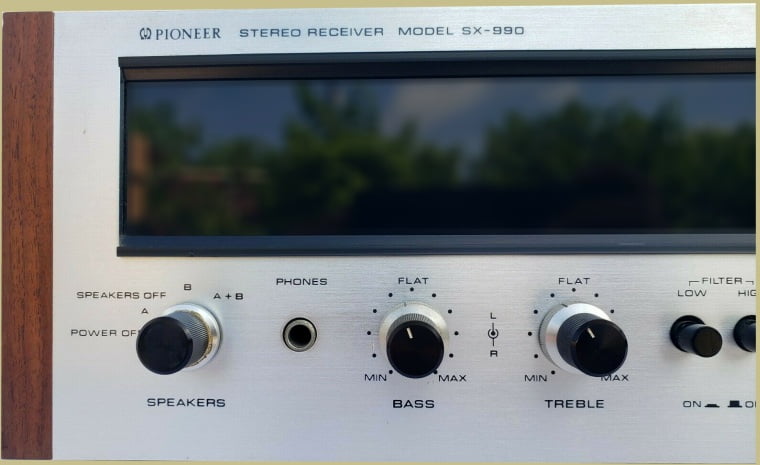
The Pioneer SX-990 is a receiver that spanned the transition from tube design to solid state design. It was produced in 1970-1971 and is all solid state. It retailed for $299.95 when it debuted and was a fairly popular model. It fell into the middle range of Pioneer’s receiver line at the time and put out 28 watts per channel into 8 ohms. The other models in the line included the entry level SX-440, the SX-550, SX-770, the SX-1500TD and the top-of-the-line (totl) SX-2500. As I mentioned, most manufacturers were shifting to solid state designs at the time and power output wasn’t a huge selling point so even the totl SX-2500 only produced 72 watts per channel.

The SX-990’s design is nice. The ‘everything-silver’ style wasn’t a thing yet in 1971 and the SX-990 has black knobs and a black dial face with blue backlighting, which they called “Lunar Glow”. It also incorporated a nice walnut side cabinet. Two small, somewhat remedial, meters indicating both signal strength and tuning were also featured.

Pioneer’s SX-990 can power two sets of speakers and can handle impedance’s of 4-16 ohms. Notice that the Mode control has L, R, L+R, Stereo, and a REV setting. The REV setting reverses the left and right channels to the speakers. It also has controls for Filter (high + Low), Loudness, and Muting. It has no mid-range tone control, only Bass and Treble.

Something to be aware of regarding the SX-990 is that the tone controls are passive interstage controls and calibration from the factory wasn’t always accurate. This means that the 12 o’clock position is sometimes not where ‘flat’ is. This is only a minor annoyance as they are usually set by ear anyway. Many SX-990 owners feel that it has the most “tube-like” sound of the solid state receivers.

A few things to keep in mind regarding the SX-990. You’ll need jumpers from the Pre-amp Out to Main amp In. Without those you’ll get no sound. Also, the SX-990, like many of the other Pioneer models at that time used speaker plugs. These allowed the user to attach the speaker wires to the plugs and then insert the plugs into the back of the receiver. This may have made it easier than reaching around the back of the receiver to attach the speaker wires but over time many of these plugs were lost. Fortunately you can always fabricate something that will work or just buy a set of plugs off of eBay though they tend to be a bit pricey.
Also, the output transistors used in the SX-990 are known to fail or become noisy over time (as with many receivers that old).

The SX-990 receiver’s circuitry is well designed for the time. It utilizes a FET front end and 4 IC’s in the IF strip. This gives it very good sensitivity. In fact, the 4-gang FM tuner is one of the better ones from that era. It also incorporates inputs for two phono’s (magnetic and ceramic), a tape monitor, a MIC, as well as AUX and MAIN inputs. The pre-amp output is useful but is known to be a somewhat weak aspect of the SX-990. Notice also that it has a Center Channel output which was unique at the time. This could probably be used for a subwoofer these days.
The power amplifier is cap coupled and there is AC feedback around the coupling cap to linearize it. The circuit is very similar to the SX-626 with the exception of a different value of load resistor at the input. As mentioned above the amplifier produces 28 watts per channel with both channels driven but it can also hit 45 wpc dynamically which is a good amount of headroom.

The SX-990 was a very good receiver for its time. Whether it is worth purchasing these days is up to the potential buyer. It is a warm sounding, “tube-like” stereo with nice aesthetics. But, it does have some idiosyncrasies regarding the circuitry that could require repair or calibration with somewhat specialized equipment. If it doesn’t have the speaker plugs then that may be a few more $$ into it as well. If you’re willing to put the money into it or pay a premium for one that is already restored then the Pioneer SX-990 makes for a very good performing stereo and is a great example of early Pioneer solid state receivers.

